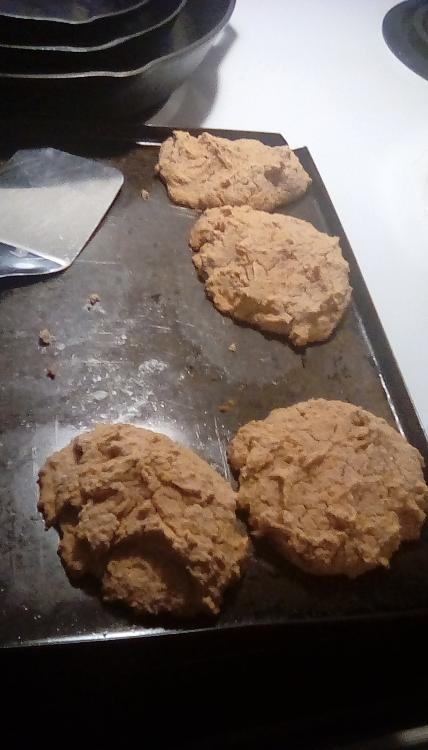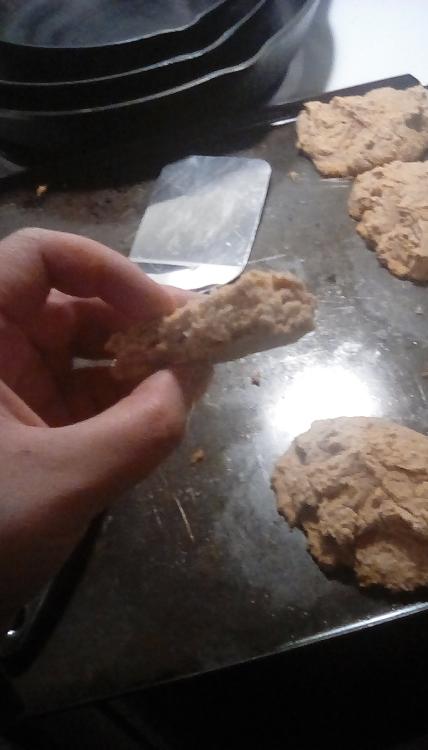Multi-grain biscuits
Posted by

 Radishrain
–
Radishrain
–
 Radishrain
–
Radishrain
–

Because we're staying home, on account of COVID-19, we've dipped into our food storage and ground a bunch of grains and some beans. (We're running out of store-bought bread, although we're no strangers to cooking or baking bread.)
So, I'm trying a similar recipe to the experimental one (a recipe in development, I mean) for biscuits posted at our sister site, except I used baking powder instead of baking soda, I used a heaping tablespoonful of brown sugar, I added two cups of water, and instead of white flour, I used a combination of whole wheat flour, millet, white bean, and cornmeal (from popcorn), all freshly ground. It's by far mostly wheat (mostly a lighter wheat, but there's a little hard red wheat flour mixed in).
The oil I used was avocado oil, although I oiled the baking sheet with extra virgin olive oil (since it's a pretty thick oil); they were slipping as I took them out of the oven (so, I suppose it worked well).
I've never been a believer that biscuits have to be flaky (with that layered look), nor buttery-tasting. They taste just as good (if not better) with biscuits and gravy if they're neither of those things. So, that's one of the reasons I use oil instead of butter or such. (I've never tried to make biscuits flaky.) I'm not sure what these multigrain ones would be like with gravy. Flaky biscuits are nice without gravy, but they're a whole different kind of biscuit, and too much work just to smother it in gravy so that you don't even notice the delectable flakiness and the rich buttery taste. But yeah, I wasn't aiming to make biscuits and gravy here, particularly (I just wanted something simple and decent-tasting to replace or improve upon bread, nutritionally speaking, which wouldn't require yeast or dairy.)
My first observation was that the extra water was unnecessary. Edit: In retrospect, it makes them flatter, which is very nice for some purposes.
My second observation was that it's not rising smoothly as it should with baking powder; I might as well have used baking soda. It's still cooking. I'm curious what the bean flour and cornmeal will do to it.
The flours were all freshly ground in a Wondermill. I prefer the flour to be ground a few days in advance at least for optimal digestion, however, but that's me.
I was tempted to use blended up tomatoes instead of water, but there was no rice in it; so, I decided it was unnecessary. The tomatoes would be to counteract the immediate effects of high mercury in rice, should the rice be high in mercury. Also, they would add lycopene, and hopefully some umami. Not sure how it'll turn out, but I want to try it.
Okay, it's done. I cooked it for about 30 minutes on 375° F.
The taste is quite good, and the texture is fluffy (but you definitely need a plate). I could smell the bean and corn in it (so, it's a good thing that beans and corn go well together—think cornbread and chili).
I ate it unadorned at first. When I tried it with butter, it tasted very different; astonishingly like buttered toast. When I added butter and jam, it tasted sort of like toast with butter and jam on it, but not as much like toast as it did with only butter on the biscuits.
It feels nutritious, as in it gives the stomach a more complete feeling than just plain wheat flour biscuits do. It feels even more nutritious when buttered.
They're a bit crumbly, but not super crumbly. They're not dry like cornbread often is.
I used to avoid using wheat as a base for biscuits when adding other grains (probably a habit of my once being on a gluten-free diet for a few years), but I think I'm converted to it, now—I think it can be better than just plain wheat. I used to do all wheat or no wheat.
If you're curious about my gluten-free diet (and why I'm not on one now), I had issues with gluten, but when I took food grade diatomaceous earth and milk thistle for a good while, and later went on a low rice diet, I no longer had big issues with wheat. I'm thinking the issue was mercury toxicity rather than Celiac disease (rice can be high in mercury, and food grade diatomaceous earth chelates mercury; mercury can block the enzymes needed to digest wheat gluten and milk casein). I only need to take food grade diatomaceous earth on occasion, now, though. The FGDE also seems to help my tolerance to milk, sugar, raw foods, legumes, and pretty much everything; I was tempted to put some in the biscuits, but I forgot (and it's just as well; I seem to be tolerating them well without it).
Here's the recipe I used all in one spot (this isn't a recommended recipe per se, as the appearance could be improved—they look like large, jagged cookies, not that I mind the appearance of cookies—but it is quite good, and a very usable recipe):
3 cups multigrain flour (mostly wheat, with a little millet, corn, and white bean flour; 2 parts millet flour, 2 parts cornmeal, 1 part bean flour, and a whole lot of parts wheat flour)
A heaping tablespoon of brown sugar
1 teaspoon iodized salt
1½ teaspoons baking powder
2 cups water
2 tablespoons avocado oil
Bake on 375° F. for 30 minutes. Grease the pan with extra virgin olive oil.
Here are a couple pictures:


wheat_
millet_
bean_
popcorn_
biscuit_
multigrain_
recipe_
covid19_
mercury_
gluten_
You could pass these off as vegan_, if you refrain from buttering them (but veganism is not my personal philosophy—although I do believe that animals deserve respect and love).
So, I'm trying a similar recipe to the experimental one (a recipe in development, I mean) for biscuits posted at our sister site, except I used baking powder instead of baking soda, I used a heaping tablespoonful of brown sugar, I added two cups of water, and instead of white flour, I used a combination of whole wheat flour, millet, white bean, and cornmeal (from popcorn), all freshly ground. It's by far mostly wheat (mostly a lighter wheat, but there's a little hard red wheat flour mixed in).
The oil I used was avocado oil, although I oiled the baking sheet with extra virgin olive oil (since it's a pretty thick oil); they were slipping as I took them out of the oven (so, I suppose it worked well).
I've never been a believer that biscuits have to be flaky (with that layered look), nor buttery-tasting. They taste just as good (if not better) with biscuits and gravy if they're neither of those things. So, that's one of the reasons I use oil instead of butter or such. (I've never tried to make biscuits flaky.) I'm not sure what these multigrain ones would be like with gravy. Flaky biscuits are nice without gravy, but they're a whole different kind of biscuit, and too much work just to smother it in gravy so that you don't even notice the delectable flakiness and the rich buttery taste. But yeah, I wasn't aiming to make biscuits and gravy here, particularly (I just wanted something simple and decent-tasting to replace or improve upon bread, nutritionally speaking, which wouldn't require yeast or dairy.)
My first observation was that the extra water was unnecessary. Edit: In retrospect, it makes them flatter, which is very nice for some purposes.
My second observation was that it's not rising smoothly as it should with baking powder; I might as well have used baking soda. It's still cooking. I'm curious what the bean flour and cornmeal will do to it.
The flours were all freshly ground in a Wondermill. I prefer the flour to be ground a few days in advance at least for optimal digestion, however, but that's me.
I was tempted to use blended up tomatoes instead of water, but there was no rice in it; so, I decided it was unnecessary. The tomatoes would be to counteract the immediate effects of high mercury in rice, should the rice be high in mercury. Also, they would add lycopene, and hopefully some umami. Not sure how it'll turn out, but I want to try it.
Okay, it's done. I cooked it for about 30 minutes on 375° F.
The taste is quite good, and the texture is fluffy (but you definitely need a plate). I could smell the bean and corn in it (so, it's a good thing that beans and corn go well together—think cornbread and chili).
I ate it unadorned at first. When I tried it with butter, it tasted very different; astonishingly like buttered toast. When I added butter and jam, it tasted sort of like toast with butter and jam on it, but not as much like toast as it did with only butter on the biscuits.
It feels nutritious, as in it gives the stomach a more complete feeling than just plain wheat flour biscuits do. It feels even more nutritious when buttered.
They're a bit crumbly, but not super crumbly. They're not dry like cornbread often is.
I used to avoid using wheat as a base for biscuits when adding other grains (probably a habit of my once being on a gluten-free diet for a few years), but I think I'm converted to it, now—I think it can be better than just plain wheat. I used to do all wheat or no wheat.
If you're curious about my gluten-free diet (and why I'm not on one now), I had issues with gluten, but when I took food grade diatomaceous earth and milk thistle for a good while, and later went on a low rice diet, I no longer had big issues with wheat. I'm thinking the issue was mercury toxicity rather than Celiac disease (rice can be high in mercury, and food grade diatomaceous earth chelates mercury; mercury can block the enzymes needed to digest wheat gluten and milk casein). I only need to take food grade diatomaceous earth on occasion, now, though. The FGDE also seems to help my tolerance to milk, sugar, raw foods, legumes, and pretty much everything; I was tempted to put some in the biscuits, but I forgot (and it's just as well; I seem to be tolerating them well without it).
Here's the recipe I used all in one spot (this isn't a recommended recipe per se, as the appearance could be improved—they look like large, jagged cookies, not that I mind the appearance of cookies—but it is quite good, and a very usable recipe):
3 cups multigrain flour (mostly wheat, with a little millet, corn, and white bean flour; 2 parts millet flour, 2 parts cornmeal, 1 part bean flour, and a whole lot of parts wheat flour)
A heaping tablespoon of brown sugar
1 teaspoon iodized salt
1½ teaspoons baking powder
2 cups water
2 tablespoons avocado oil
Bake on 375° F. for 30 minutes. Grease the pan with extra virgin olive oil.
Here are a couple pictures:


wheat_
millet_
bean_
popcorn_
biscuit_
multigrain_
recipe_
covid19_
mercury_
gluten_
You could pass these off as vegan_, if you refrain from buttering them (but veganism is not my personal philosophy—although I do believe that animals deserve respect and love).
| Free forum by Nabble | Edit this page |
3 Comments
Re: Multi-grain biscuits
Re: Multi-grain biscuits
Whole wheat biscuits, with vegetable powders